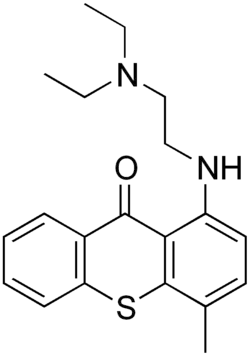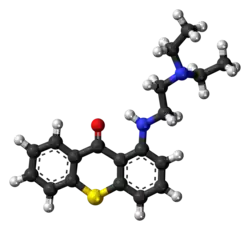Lucanthone
 | |
 | |
| Clinical data | |
|---|---|
| ATC code |
|
| Identifiers | |
| |
| CAS Number | |
| PubChem CID | |
| DrugBank | |
| ChemSpider | |
| UNII | |
| ChEBI | |
| CompTox Dashboard (EPA) | |
| ECHA InfoCard | 100.006.849 |
| Chemical and physical data | |
| Formula | C20H24N2OS |
| Molar mass | 340.49 g·mol−1 |
| | |
Lucanthone is a drug used to treat parasitic diseases such as bilharziasis[1] and schistosomiasis[2] It is a prodrug and is converted to the active metabolite hycanthone.[3]
Mechanism of action
Hycanthone binds to acetylcholine receptors in the worm[4] and results in increased sensitivity to stimulation by 5-HT causing increase in motility, paired worms are separated and reproduction is stopped. It causes damage of the integument and vitelline duct.
References
- ^ Blair DM (1958). "Lucanthone hydrochloride; a review". Bulletin of the World Health Organization. 18 (5–6): 989–1010. PMC 2537946. PMID 13573122.
- ^ Standen O (1963). "Chemotherapy of Helminthic Infections". In Schnitzer RJ, Hawking F (eds.). Experimental chemotherapy. Vol. 1. New York, New York: Academic Press. p. 770. ISBN 978-1-4832-7308-2.
{{cite book}}: ISBN / Date incompatibility (help) - ^ Rosi D, Peruzzotti G, Dennis EW, Berberian DA, Freele H, Tullar BF, Archer S (September 1967). "Hycanthone, a new active metabolite of lucanthone". Journal of Medicinal Chemistry. 10 (5): 867–76. doi:10.1021/jm00317a025. PMID 4963368.
- ^ Hillman GR, Senft AW (September 1975). "Anticholinergic properties of the antischistosomal drug hycanthone". The American Journal of Tropical Medicine and Hygiene. 24 (5): 827–34. doi:10.4269/ajtmh.1975.24.827. PMID 1190369.